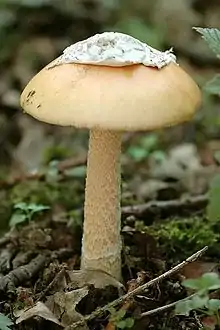Amanita arocheae
Amanita arocheae, also known as the Latin American death cap,[1] is a mushroom of the large genus Amanita, which occurs in Mexico, Central America and South America. Deadly poisonous, it is a member of section Phalloideae and related to the death cap A. phalloides.
| Latin American death cap | |
|---|---|
 | |
| Scientific classification | |
| Kingdom: | Fungi |
| Division: | Basidiomycota |
| Class: | Agaricomycetes |
| Order: | Agaricales |
| Family: | Amanitaceae |
| Genus: | Amanita |
| Species: | A. arocheae |
| Binomial name | |
| Amanita arocheae Tulloss, Ovrebo & Halling (1992) | |
| Amanita arocheae | |
|---|---|
float | |
| gills on hymenium | |
| cap is convex | |
| hymenium is free | |
| stipe has a ring and volva | |
| spore print is white | |
| ecology is mycorrhizal | |
| edibility: deadly | |
It is known as hongo gris in Mexico, where it is found under oak. It differs from the death cap in the colour of its cap, which is brownish to grayish.
Taxonomy
The species was first described in 1992 by mycologists Rod Tullos, C.L. Ovebro, and Roy Halling. It is closely related to Amanita phalloides, and was referred to this species in the past by Mexican mycologists. It is named after mycologist Regla Maria Aroche.[2]
Description
The cap is convex to plano-convex, reaching dimensions of 3–11 cm (1.2–4.3 in). The cap surface is sticky or tacky. The center of the cap is gray to brown with a gray edge. The white gills are closely crowded together and free from attachment to the stipe. In young mushrooms, the gills exude drops of clear fluid. The dry, white to pale grey stipe measures 8–20 cm (3.1–7.9 in) long by 0.5–1.7 cm (0.2–0.7 in) thick. It has a bulbous base, a white to grey, membranous volva at the stipe base, and white mycelium at the base. The stipe has a white ring.[3] The odor of the flesh is mild to unpleasant.[1]
The spore print is white. Spores are smooth, amyloid, spherical or roughly so, and measure 7–10 by 6.8–9.5 μm. Clamp connections are absent from the hyphae.[3]
Similar species
Amanita vaginata is similar, however A. vaginata has non-amyloid spores and lacks of ring in the stipe
Habitat and distribution
Amanita arochae is a mycorrhizal species that associates with oak as a host. It is found in Mexico, Costa Rica, and Colombia.[3]
References
- Tulloss R. "Amanita arocheae". Amanitaceae.org. Retrieved 2013-12-25.
- Tulloss RE, Ovrebo CL, Halling RE (1992). "Studies on Amanita (Amanitaceae) from Andean Colombia". Memoirs of the New York Botanical Garden. 66: 23.
- Halling RE, Mueller GM (2005). Common Mushrooms of the Talamanca Mountains, Costa Rica. New York, New York: New York Botanical Garden Press. p. 26. ISBN 978-0-89327-460-3.
